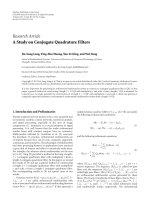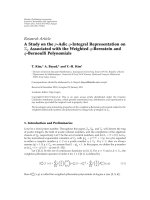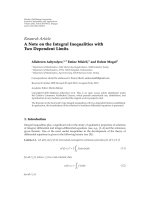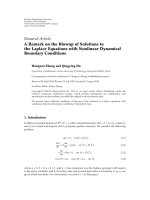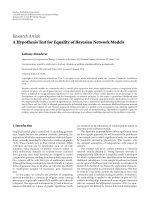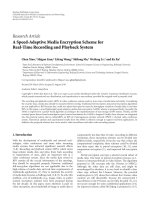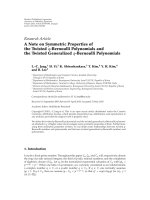Báo cáo sinh học: "Research Article A Note on Symmetric Properties of the Twisted q-Bernoulli Polynomials and the Twisted Generalized q-Bernoulli Polynomials" docx
Bạn đang xem bản rút gọn của tài liệu. Xem và tải ngay bản đầy đủ của tài liệu tại đây (515.9 KB, 13 trang )
Hindawi Publishing Corporation
Advances in Difference Equations
Volume 2010, Article ID 801580, 13 pages
doi:10.1155/2010/801580
Research Article
A Note on Symmetric Properties of
the Twisted q-Bernoulli Polynomials and
the Twisted Generalized q-Bernoulli Polynomials
L C. Jang,
1
H. Yi,
2
K. Shivashankara,
3
T. Kim,
4
Y. H. Kim,
4
and B. Lee
5
1
Department of Mathematics and Computer Science, KonKuk University,
Chungju 138-70, Republic of Korea
2
Department of Mathematics, Kwangwoon University, Seoul 139-701, Republic of Korea
3
Department of Mathematics, Yuvaraja’s College, University of Mysore, Mysore 570# 005, India
4
Division of General Education-Mathematics, Kwangwoon University, Seoul 139-701, Republic of Korea
5
Department of Wireless Communications Engineering, Kwangwoon University,
Seoul 139-701, Republic of Korea
Correspondence should be addressed to H. Yi,
Received 11 September 2009; Revised 14 April 2010; Accepted 31 May 2010
Academic Editor: Abdelkader Boucherif
Copyright q 2010 L C. Jang et al. This is an open access article distributed under the Creative
Commons Attribution License, which permits unrestricted use, distribution, and reproduction in
any medium, provided the original work is properly cited.
We define the twisted q-Bernoulli polynomials and the twisted generalized q-Bernoulli polynomi-
als attached to χ of higher order and investigate some symmetric properties of them. Furthermore,
using these symmetric properties of them, we can obtain some relationships between twisted q-
Bernoulli numbers and polynomials and between twisted generalized q-Bernoulli numbers and
polynomials.
1. Introduction
Let p be a fi xed prime number. Throughout this paper Z
p
, Q
p
,andC
p
will, respectively, denote
the ring of p-adic rational integers, the field of p-adic rational numbers, and the completion
of algebraic closure of Q
p
.Letv
p
be the normalized exponential valuation of C
p
with |p|
p
p
−v
p
p
p
−1
. When one talks of q-extension, q is variously considered as an indeterminate,
a complex number q ∈ C, or a p-adic number q ∈ C
p
.Ifq ∈ C, one normally assumes
|q| < 1. If q ∈ C
p
, then we assume |q − 1|
p
<p
−1/p−1
, so that q
x
expx log q for |x|
p
≤ 1
cf. 1–32.
2 Advances in Difference Equations
For N, d ∈ N,weset
X X
d
lim
←
N
Z
dp
N
Z
,X
1
Z
p
1.1
see 1–13. The Bernoulli numbers B
n
and polynomials B
n
x are defined by the generating
function as
t
e
t
− 1
∞
n0
B
n
t
n
n!
,
1.2
t
e
t
− 1
e
xt
∞
n0
B
n
x
t
n
n!
1.3
cf. 17, 18, 21, 24, 26. Let UDX be the set of uniformly differentiable functions on X. For
f ∈ UDX,thep-adic invariant integral on Z
p
is defined as
I
f
X
f
x
dx lim
N →∞
1
dp
N
dp
N
−1
x0
f
x
.
1.4
Note that
X
fxdx
Z
p
fxdx see 27.Letf
n
x be a translation with f
n
xfx n.
We note that
I
f
n
I
f
n−1
i0
f
i
1.5
cf. 1–32.Kim18 studied the symmetric properties of the q-Bernoulli numbers and
polynomials as follows:
t log q
qe
t
− 1
e
xt
∞
n0
B
q
n
x
t
n
n!
.
1.6
In this paper, we define the twisted q-Bernoulli polynomials and the twisted
generalized q-Bernoulli polynomials attached to χ of higher order and investigate some
symmetric properties of them. Furthermore, using these symmetric properties of them, we
can obtain some relationships between the twisted q-Bernoulli numbers and polynomials
and between the twisted generalized q-Bernoulli numbers and polynomials attached to χ of
higher order.
Advances in Difference Equations 3
2. The Twisted q-Bernoulli Polynomials
Let C
p
∞
n≥1
C
p
n
lim
n →∞
C
p
n
be the locally constant space, where C
p
n
{ξ | ξ
p
n
1} is the
cyclic group of order p
n
. For w ∈ C
p
∞
, we denote the locally constant function by
φ
w
: Z
p
−→ C
p
,x−→ w
x
2.1
cf. 2, 3, 21, 24. If we take fxφ
w
xq
x
e
tx
, then
Z
p
e
xt
w
x
q
x
dx
log q t
wqe
t
− 1
.
2.2
Nowwedefinetheq-extension of twisted Bernoulli numbers and polynomials as
follows:
log q t
wqe
t
− 1
∞
n0
B
q
n,w
t
n
n!
, 2.3
log q t
wqe
t
− 1
e
tx
∞
n0
B
q
n,w
x
t
n
n!
2.4
see 31.From1.5, 2.2, 2.3,and2.4, we can derive
Z
p
w
y
q
y
x y
n
dy B
q
n,w
x
,
Z
p
w
y
q
y
y
n
dy B
q
n,w
.
2.5
By 1.5, we can see that
1
log q t
Z
p
w
nx
q
nx
e
nxt
dx −
Z
p
w
x
q
x
e
xt
dx
w
n
q
n
e
nt
− 1
t log q
Z
p
w
x
q
x
e
xt
dx
w
n
q
n
e
nt
− 1
wqe
t
− 1
n−1
i0
w
i
q
i
e
it
∞
k0
n−1
i0
i
k
w
i
q
i
t
k
k!
.
2.6
4 Advances in Difference Equations
In 1.4,itiseasytoshowthat
1
log q t
Z
p
w
nx
q
nx
e
nxt
dx −
Z
p
w
x
q
x
e
xt
dx
n
Z
p
w
x
q
x
e
xt
dx
Z
p
w
nx
q
nx
e
nxt
dx
. 2.7
For each integer k ≥ 0, let
S
q
k,w
n
0
k
1
k
wq 2
k
w
2
q
2
··· n
k
w
n
q
n
.
2.8
From 2.6, 2.7,and2.8, we derive
1
log q t
Z
p
w
nx
q
nx
e
nxt
dx −
Z
p
w
x
q
x
e
xt
dx
n
Z
p
w
x
q
x
e
xt
dx
Z
p
w
nx
q
nx
e
nxt
dx
∞
k0
S
q
k,w
n − 1
t
k
k!
.
2.9
From 2.9,wenotethat
B
q
k,w
n
− B
q
k,w
kS
q
k−1,w
n − 1
log qS
q
k,w
n − 1
,
2.10
for all k, n ∈ N.Letu
1
,u
2
∈ N and w ∈ C
p
∞
; then we have
Z
p
w
u
1
x
1
u
2
x
2
q
u
1
x
1
u
2
x
2
e
u
1
x
1
u
2
x
2
dx
1
dx
2
Z
p
w
u
1
u
2
x
q
u
1
u
2
x
e
u
1
u
2
xt
dx
t log q
w
u
1
u
2
q
u
1
u
2
e
u
1
t
− 1
w
u
2
q
u
2
e
u
2
t
− 1
. 2.11
By 2.9,weseethat
u
1
Z
p
w
x
q
x
e
xt
dx
Z
p
w
u
1
x
q
u
1
x
e
u
1
xt
dx
∞
l0
u
1
−1
k0
k
l
w
k
q
k
t
l
l!
∞
l0
S
q
l,w
u
1
− 1
t
l
l!
. 2.12
Let T
w
u
1
,u
2
; x, t be as follows:
T
w
u
1
,u
2
; x, t
Z
p
w
u
1
x
1
u
2
x
2
q
u
1
x
1
u
2
x
2
e
u
1
x
1
u
2
x
2
u
1
u
2
xt
dx
1
dx
2
Z
p
w
u
1
u
2
x
q
u
1
u
2
x
e
u
1
u
2
xt
dx
.
2.13
Then we have
T
w
u
1
,u
2
; x, t
t log q
e
u
1
u
2
t
w
u
1
u
2
q
u
1
u
2
e
u
1
u
2
t
− 1
w
u
1
q
u
1
e
u
1
t
− 1
w
u
2
q
u
2
e
u
2
t
− 1
. 2.14
Advances in Difference Equations 5
From 2.13, we derive
T
w
u
1
,u
2
; x, t
1
u
1
Z
p
w
u
1
x
1
q
u
1
x
1
e
u
1
x
1
u
2
xt
dx
1
⎛
⎝
u
1
Z
p
w
u
2
x
2
q
u
2
x
2
e
u
2
x
2
t
Z
p
w
u
1
u
2
x
q
u
1
u
2
x
e
u
1
u
2
xt
dx
⎞
⎠
. 2.15
By 2.4, 2.12,and2.15, we can see that
T
w
u
1
,u
2
; x, t
1
u
1
∞
i0
B
q
u
1
i,w
u
1
u
2
x
u
i
1
t
i
i!
∞
l0
S
q
u
2
l,w
u
2
u
1
− 1
u
l
2
t
l
l!
∞
n0
n
i0
n
i
B
q
u
1
i,w
u
1
u
2
x
S
q
u
2
n−i,w
u
2
u
1
− 1
u
i−1
1
u
n−i
2
t
n
n!
.
2.16
By the symmetry of p-adic invariant integral on Z
p
,wealsoseethat
T
w
u
1
,u
2
; x, t
1
u
2
Z
p
w
u
2
x
2
q
u
2
x
2
e
u
2
x
2
u
1
xt
dx
2
⎛
⎝
u
2
Z
p
w
u
1
x
1
q
u
1
x
1
e
u
1
x
1
t
Z
p
w
u
1
u
2
x
q
u
1
u
2
x
e
u
1
u
2
xt
dx
⎞
⎠
∞
n0
n
i0
n
i
B
q
u
2
i,w
u
2
u
1
x
S
q
u
1
n−i,w
u
1
u
2
− 1
u
i−1
2
u
n−i
1
t
n
n!
.
2.17
By comparing the coefficients of t
n
/n! on both sides of 2.16 and 2.17,weobtainthe
following theorem.
Theorem 2.1. Let u
1
,u
2
,n∈ N. Then for all x ∈ Z
p
,
n
i0
n
i
B
q
u
1
i,w
u
1
u
2
x
S
q
u
2
n−i,w
u
2
u
1
− 1
u
i−1
1
u
n−i
2
n
i0
n
i
B
q
u
2
i,w
u
2
u
1
x
S
q
u
1
n−i,w
u
1
u
2
− 1
u
i−1
2
u
n−i
1
,
2.18
where
n
i
is the binomial coefficient.
From Theorem 2.1, if we take u
2
1, then we have the following corollary.
Corollary 2.2. For m ≥ 0, one we has
B
q
i,w
u
1
x
n
i0
n
i
B
q
u
1
i,w
u
1
x
S
q
n−i,w
u
1
− 1
u
i−1
1
,
2.19
where
n
i
is the binomial coefficient.
6 Advances in Difference Equations
By 2.17, 2.18,and2.19, we can see that
T
w
u
1
,u
2
; x, t
e
u
1
u
2
xt
u
1
Z
p
w
u
1
x
q
u
1
x
1
e
u
1
x
1
t
dx
1
⎛
⎝
u
1
Z
p
w
u
2
x
2
q
u
2
x
2
e
u
2
x
2
t
dx
2
Z
p
w
u
1
u
2
x
q
u
1
u
2
x
e
u
1
u
2
xt
dx
⎞
⎠
e
u
1
u
2
xt
u
1
Z
p
w
u
1
x
q
u
1
x
1
e
u
1
x
1
t
dx
1
u
1
−1
i0
w
u
2
i
q
u
2
i
e
u
2
it
1
u
1
u
1
−1
i0
w
u
2
i
q
u
2
i
Z
p
w
u
1
x
q
u
1
x
e
x
1
u
2
xu
2
/u
1
itu
1
dx
1
∞
n0
u
1
−1
i0
B
q
u
1
n,w
u
1
u
2
x
u
2
u
1
i
u
n−1
1
w
u
2
i
q
u
2
i
t
n
n!
.
2.20
From the symmetry of T
w
u
1
,u
2
; x, t, we can also derive
T
w
u
1
,u
2
; x, t
∞
n0
u
2
−1
i0
B
q
u
2
n,w
u
2
u
1
x
u
1
u
2
i
u
n−1
2
w
u
1
i
q
u
1
i
t
n
n!
.
2.21
By comparing the coefficients of t
n
/n! on both sides of 2.20 and 2.21,weobtainthe
following theorem.
Theorem 2.3. For m ∈ Z
, u
1
,u
2
∈ N, we have
u
1
−1
i0
B
q
u
1
n,w
u
1
u
2
x
u
2
u
1
i
u
n−1
1
w
u
2
i
q
u
2
i
u
2
−1
i0
B
q
u
2
n,w
u
2
u
1
x
u
1
u
2
i
u
n−1
2
w
u
1
i
q
u
1
i
.
2.22
We note that by setting u
2
1inTheorem 2.3, we get the following multiplication
theorem for the twisted q-Bernoulli polynomials.
Theorem 2.4. For m ∈ Z
, u
1
∈ N, one has
B
q
n,w
u
1
x
u
n−1
1
u
1
−1
i0
B
q
u
1
n,w
u
1
x
i
u
1
w
i
q
i
.
2.23
Remark 2.5. 18, Kim suggested open questions related to finding symmetric properties for
Carlitz q-Bernoulli numbers. In this paper, we give the symmetric property for q-Bernoulli
numbers in the viewpoint to give the answer of Kim’s open questions.
3. The Twisted Generalized Bernoulli Polynomials
Attached to χ of Higher Order
In this section, we consider the generalized Bernoulli numbers and polynomials and then
define the twisted generalized Bernoulli polynomials attached to χ of higher order by using
Advances in Difference Equations 7
multivariate p-adic invariant integrals on Z
p
.Letχ be Dirichlet’s character with conductor
d ∈ N. Then the generalized Bernoulli numbers B
n,χ
and polynomials B
n,χ
x attached to χ
are defined as
t
d−1
a0
χ
a
e
at
e
dt
− 1
∞
n0
B
n,χ
t
n
n!
,
3.1
t
d−1
a0
χ
a
e
at
e
dt
− 1
e
xt
∞
n0
B
n,χ
x
t
n
n!
3.2
cf. 2, 18, 23, 27.
Let C
p
∞
n≥1
C
p
n
lim
n →∞
C
p
n
be the locally constant space, where C
p
n
{w | w
p
n
1} is the cyclic group of order p
n
. For w ∈ C
p
∞
, we denote the locally constant function by
φ
w
: Z
p
−→ C
p
,x−→ w
x
3.3
cf. 2, 3, 21, 23, 24. If we take fxχxe
tx
φ
w
xq
x
,forq ∈ C
p
with |q − 1|
p
< 1, then it is
obvious from 3.1 that
X
χ
x
e
tx
w
x
q
x
dx
t log q
d−1
a0
χ
a
w
a
q
a
e
at
w
d
q
d
e
dt
− 1
.
3.4
Now we define the twisted generalized Bernoulli numbers B
q
n,χ,w
and polynomials B
q
n,χ,w
x
attached to χ as follows:
t log q
d−1
a0
χ
a
w
a
q
a
e
at
w
d
q
d
e
dt
− 1
∞
n0
B
q
n,χ,w
t
n
n!
, 3.5
t log q
d−1
a0
χ
a
w
a
q
a
e
at
e
xt
w
d
q
d
e
dt
− 1
∞
n0
B
q
n,χ,w
x
t
n
n!
3.6
for each w ∈ C
p
∞
see 31, 32.By3.5 and 3.6,
X
χ
x
x
n
w
x
q
x
dx B
q
n,χ,w
,
X
χ
y
x y
n
w
y
q
y
dy B
q
n,χ,w
x
.
3.7
8 Advances in Difference Equations
Thus we have
1
log q t
X
χ
x
e
ndxt
w
nx
q
nx
dx −
X
χ
x
e
xt
w
x
q
x
dx
nd
X
χ
x
e
xt
w
x
q
x
dx
X
e
ndxt
w
ndx
q
ndx
dx
w
nd
q
nd
e
ndt
− 1
w
d
q
d
e
dt
− 1
d−1
i0
χ
i
e
it
w
i
q
i
.
3.8
Then
1
log q t
X
χ
x
e
ndxt
w
nx
q
nx
dx −
X
χ
x
e
xt
w
x
q
x
dx
nd−1
l0
χ
l
e
lt
w
l
q
l
∞
k0
nd−1
l0
χ
l
l
k
w
l
q
l
t
k
k!
.
3.9
Let us define the p-adic twisted q-function T
q
k,w
χ, n as follows:
T
q
k,w
χ, n
n
l0
χ
l
l
k
w
l
q
l
.
3.10
By 3.9 and 3.10,weseethat
1
log q t
X
χ
x
e
ndxt
w
ndx
q
ndx
dx −
X
χ
x
e
xt
w
x
q
x
dx
∞
k0
T
q
k,w
χ, nd − 1
t
k
k!
.
3.11
Thus,
X
χ
x
nd x
k
w
nx
q
nx
dx −
X
χ
x
x
k
w
x
q
x
dx
t log q
T
q
k,w
χ, nd − 1
,
3.12
for all k, n,d ∈ N. This means that
B
q
k,χ,w
nd
− B
q
n,χ,w
t log q
T
q
k,w
χ, nd − 1
,
3.13
Advances in Difference Equations 9
for all k, n,d ∈ N. For all u
1
,u
2
,d ∈ N, we have
d
X
X
χ
x
1
χ
x
2
e
w
1
x
1
w
2
x
2
t
w
u
1
x
1
u
2
x
2
q
u
1
x
1
u
2
x
2
dx
1
dx
2
X
e
du
1
u
2
xt
w
du
1
u
2
x
q
du
1
u
2
x
dx
t log q
e
du
1
u
2
t
w
du
1
u
2
q
du
1
u
2
− 1
e
du
1
t
w
du
1
q
du
1
− 1
e
du
2
t
w
du
2
q
du
2
− 1
×
d−1
a0
χ
a
e
u
1
at
w
u
1
a
q
u
1
a
d−1
b0
χ
b
e
u
2
bt
w
u
2
b
q
u
2
b
.
3.14
The twisted generalized Bernoulli numbers B
k,q
n,χ,w
and polynomials B
k,q
n,χ,w
x attached
to χ of order k are defined as
t log q
d−1
a0
χ
a
w
a
q
a
e
at
w
d
q
d
e
dt
− 1
k
∞
n0
B
k,q
n,χ,w
t
n
n!
,
3.15
t log q
d−1
a0
χ
a
w
a
q
a
e
at
w
d
q
d
e
dt
− 1
k
e
xt
∞
n0
B
k,q
n,χ,w
x
t
n
n!
3.16
for each w ∈ C
p
∞
. For u
1
,u
2
∈ N,weset
K
q
w
m, χ; u
1
,u
2
d
X
m
m
i1
χ
x
i
e
m
i1
x
i
u
2
xu
1
t
w
m
i1
x
i
u
2
xu
1
q
m
i1
x
i
u
2
xu
1
dx
1
···dx
m
X
e
du
1
u
2
xt
w
du
1
u
2
x
q
du
1
u
2
x
dx
×
X
m
m
i1
χ
x
i
e
m
i1
x
i
u
1
yu
2
t
w
m
i1
x
i
u
1
yu
2
q
m
i1
x
i
u
1
yu
1
dx
1
···dx
m
,
3.17
where
X
m
fx
1
···x
m
dx
1
···dx
m
X
···
X
fx
1
, ,x
m
dx
1
···dx
m
.In3.17,wenotethat
K
q
w
m, χ; u
1
,u
2
is symmetric in u
1
,u
2
.From3.17, we have
K
q
w
m, χ; u
1
,u
2
X
m
m
i1
χ
x
i
e
m
i1
x
i
u
2
t
w
m
i1
x
i
u
2
q
m
i1
x
i
u
2
dx
1
···dx
m
× e
u
1
u
2
xt
w
u
1
u
2
x
q
u
1
u
2
x
d
X
χ
x
m
e
u
2
x
m
t
w
u
2
x
m
q
u
2
x
m
dx
m
X
e
du
1
u
2
x
q
du
1
u
2
x
dx
×
X
m−1
m−1
i1
χ
x
i
e
m−1
i1
x
i
u
2
t
w
m−1
i1
x
i
u
2
q
m−1
i1
x
i
u
2
dx
1
···dx
m−1
× e
u
1
u
2
yt
w
u
1
u
2
y
q
u
1
u
2
y
.
3.18
10 Advances in Difference Equations
Thus we can obtain
u
1
d
X
χ
x
e
xt
w
x
q
x
dx
X
e
du
2
xt
w
du
2
x
q
du
2
x
dx
∞
k0
u
1
d−1
i0
χ
i
i
k
w
i
q
i
t
k
k!
∞
k0
T
q
k,w
χ, u
1
d − 1
t
k
k!
,
e
u
1
u
2
xt
w
u
1
u
2
x
q
u
1
u
2
x
X
m
m
i1
χ
x
i
e
m
i1
x
i
u
1
t
w
m
i1
x
i
u
1
q
m
i1
x
i
u
1
dx
1
···dx
m
e
u
1
u
2
xt
w
u
1
u
2
x
q
u
1
u
2
x
u
1
e
du
1
t
w
du
1
q
du
1
− 1
d−1
a0
χ
a
e
u
1
at
w
u
1
a
q
u
1
a
∞
n0
B
m,q
n,χ,w
u
2
x
u
n
1
t
n
n!
.
3.19
From 3.19, we derive
K
q
w
m, χ; u
1
,u
2
∞
l0
B
m,q
l,χ,w
u
1
x
u
l
1
t
l
l!
∞
k0
T
q
k,w
χ, u
1
d − 1
t
k
k!
∞
i0
B
m−1,q
i,χ,w
u
1
y
u
i
2
t
i
i!
1
u
1
∞
n0
n
j0
n
j
u
j
2
u
n−j−1
1
B
m,q
n−j,χ,w
u
2
x
×
j
k0
T
q
k,w
χ, u
1
d − 1
j
k
B
m−1,q
j−k,χ,w
u
1
y
t
n
n!
.
3.20
By the symmetry of K
q
w
m, χ; u
1
,u
2
in u
1
and u
2
, we can see that
K
q
w
m, χ; u
1
,u
2
∞
n0
n
j0
n
j
u
j
1
u
n−j−1
2
B
m,q
n−j,χ,w
u
1
x
×
j
k0
T
q
k,w
χ, u
2
d − 1
j
k
B
m−1,q
j−k,χ,w
u
2
y
t
n
n!
.
3.21
By comparing the coefficients on both sides of 3.20 and 3.21, we see the following theorem.
Theorem 3.1. For d, u
1
,u
2
,m∈ N, n ∈ Z, one has
n
j0
n
j
u
j
2
u
n−j−1
1
B
m,q
n−j,χ,w
u
2
x
j
k0
T
q
k,w
χ, u
1
d − 1
j
k
B
m−1,q
j−k,χ,w
u
1
y
n
j0
n
j
u
j
1
u
n−j−1
2
B
m,q
n−j,χ,w
u
1
x
j
k0
T
q
k,w
χ, u
2
d − 1
j
k
B
m−1,q
j−k,χ,w
u
2
y
.
3.22
Advances in Difference Equations 11
Remark 3.2. If we take y 0andm 1in3.22, then we have
n
j0
n
j
u
j
2
u
n−j−1
1
B
q
n−j,χ,w
u
2
x
j
k0
T
q
k,w
χ, u
1
d − 1
j
k
n
j0
n
j
u
j
1
u
n−j−1
2
B
q
n−j,χ,w
u
1
x
j
k0
T
q
k,w
χ, u
2
d − 1
j
k
.
3.23
Now we can also calculate
K
q
w
m, χ; u
1
,u
2
∞
n0
n
k0
n
k
u
k−1
1
u
n−k
2
B
m−1,q
n−k,χ,w
u
1
y
du
1
−1
i0
B
m,q
i,χ,w
u
2
x
u
2
u
1
i
t
n
n!
.
3.24
From the symmetric property of K
q
w
m, χ; u
1
,u
2
in u
1
and u
2
, we derive
K
q
w
m, χ; u
1
,u
2
∞
n0
n
k0
n
k
u
k−1
2
u
n−k
1
B
m−1,q
n−k,χ,w
u
2
y
du
2
−1
i0
B
m,q
i,χ,w
u
1
x
u
1
u
2
i
t
n
n!
.
3.25
By comparing the coefficients on both sides of 3.24 and 3.26, we obtain the following
theorem.
Theorem 3.3. For d, u
1
,u
2
,m∈ N, n ∈ Z, we have
n
k0
n
k
u
k−1
1
u
n−k
2
B
m−1,q
n−k,χ,w
u
1
y
du
1
−1
i0
B
m,q
k,χ,w
u
2
x
u
2
u
1
i
n
k0
n
k
u
k−1
2
u
n−k
1
B
m−1,q
n−k,χ,w
u
2
y
du
2
−1
i0
B
m,q
k,χ,w
u
1
x
u
1
u
2
i
.
3.26
Remark 3.4. If we take y 0andm 1in3.26, then one has
u
n−1
1
du
1
−1
i0
B
q
n,χ,w
u
2
x
u
2
u
1
i
u
n−1
2
du
2
−1
i0
B
q
n,χ,w
u
1
x
u
1
u
2
i
.
3.27
Remark 3.5. In our results for q 1, we can also derive similar results, which were treated
in 27. In this paper, we used the p-adic integrals to derive the symmetric properties of
the q-Bernoulli polynomials. By using the symmetric properties of p-adic integral on X,we
can easily derive many interesting symmetric properties related to Bernoulli numbers and
polynomials.
12 Advances in Difference Equations
Acknowledgments
The authors express Their sincere gratitude to referees for their valuable suggestions and
comments. This work has been conducted by the Research Grant of Kwangwoon University
in 2010.
References
1 M. Cenkci, Y. Simsek, and V. Kurt, “Further remarks on multiple p-adic q-L-function of two variables,”
Advanced Studies in Contemporary Mathematics, vol. 14, no. 1, pp. 49–68, 2007.
2 L C. Jang, “On a q-analogue of the p-adic generalized twisted L-functions and p-adic q-integrals,”
Journal of the Korean Mathematical Society, vol. 44, no. 1, pp. 1–10, 2007.
3 L C. Jang, “Multiple twisted q-Euler numbers and polynomials associated with p-adic q-integrals,”
Advances in Difference Equations, vol. 2008, Article ID 738603, 11 pages, 2008.
4 L C. Jang, S D. Kim, D W. Park, and Y S. Ro, “A note on Euler number and polynomials,” Journal
of Inequalities and Applications, vol. 2006, Article ID 34602, 5 pages, 2006.
5 L C. Jang and T. Kim, “On the distribution of the q-Euler polynomials and the q-Genocchi
polynomials of higher order,” Journal of Inequalities and Applications, vol. 2008, Article ID 723615, 9
pages, 2008.
6 T. Kim, “q-Volkenborn integration,” Russian Journal of Mathematical Physics, vol. 9, no. 3, pp. 288–299,
2002.
7 T. Kim, “On Euler-Barnes multiple zeta functions,” Russian Journal of Mathematical Physics, vol. 10, no.
3, pp. 261–267, 2003.
8 T. Kim, “Analytic continuation of multiple q-zeta functions and their values at negative integers,”
Russian Journal of Mathematical Physics, vol. 11, no. 1, pp. 71–76, 2004.
9 T. Kim, “Power series and asymptotic series associated with the q-analog of the two-variable p-adic
L-function,” Russian Journal of Mathematical Physics, vol. 12, no. 2, pp. 186–196, 2005.
10 T. Kim, “Multiple
p-adic L-function,” Russian Journal of Mathematical Physics, vol. 13, no. 2, pp. 151–
157, 2006.
11 T. Kim, “A note on p-Adic q-integral on Zp associated with q-Euler numbers,” Advanced Studies in
Contemporary Mathematics, vol. 15, pp. 133–138, 2007.
12 T. Kim, “On p-adic interpolating function for q-Euler numbers and its derivatives,” Journal of
Mathematical Analysis and Applications, vol. 339, no. 1, pp. 598–608, 2008.
13 T. Kim, “On the analogs of Euler numbers and polynomials associated with p-adic q-integral on
Z
p
at
q −1,” Journal of Mathematical Analysis and Applications, vol. 331, no. 2, pp. 779–792, 2007.
14 T. Kim, “A note on p-adic q-integral on
Z
p
associated with q-Euler numbers,” Advanced Studies in
Contemporary Mathematics, vol. 15, no. 2, pp. 133–137, 2007.
15 T. Kim, “q-Euler numbers and polynomials associated with p-adic q-integrals,” Journal of Nonlinear
Mathematical Physics, vol. 14, no. 1, pp. 15–27, 2007.
16 T. Kim, “A note on some formulae for the q-Euler numbers and polynomials,” Proc. Jangjeon Math.
Soc., vol. 9, no. 2, pp. 227–232, 2006.
17 T. Kim, “q-Bernoulli numbers and polynomials associated with Gaussian binomial coefficients,”
Russian Journal of Mathematical Physics, vol. 15, no. 1, pp. 51–57, 2008.
18 T. Kim, “On the symmetries of the q-Bernoulli polynomials,” Abstract and Applied Analysis, vol. 2008,
Article ID 914367, 7 pages, 2008.
19 T. Kim, “Note on Dedekind t ype DC sums,” Advanced Studies in Contemporary Mathematics, vol. 18,
no. 2, pp. 249–260, 2009.
20 T. Kim, L C. Jang, and H. K. Pak, “A note on q-Euler and Genocchi numbers,” Proceedings of the Japan
Academy, Series A, vol. 77, no. 8, pp. 139–141, 2001.
21 T. Kim, “Note on the q-Euler numbers of higher order,” Advanced Studies in Contemporary Mathematics,
vol. 19, no. 1, pp. 25–29, 2009.
22 T. Kim, M S. Kim, L C. Jang, and S H. Rim, “New q-Euler numbers and polynomials associated with
p-adic q-integrals,” Advanced Studies in Contemporary Mathematics, vol. 15, no. 2, pp. 243–252, 2007.
23 W. Kim, Y H. Kim, and L C. Jang, “On the q-extension of apostol-euler numbers and polynomials,”
Abstract and Applied Analysis, vol. 2008, Article ID 296159, 10 pages, 2008.
Advances in Difference Equations 13
24 Y. Simsek, “Generating functions of the twisted Bernoulli numbers and polynomials associated with
their interpolation functions,” Advanced Studies in Contemporary Mathematics, vol. 16, no. 2, pp. 251–
278, 2008.
25 H. Ozden, Y. Simsek, S H. Rim, and I. N. Cangul, “A note on p-adic q-Euler measure,” Advanced
Studies in Contemporary Mathematics, vol. 14, pp. 233–239, 2007.
26 S H. Rim, Y H. Kim, B. J. Lee, and T. Kim, “Some identities of the generalized twisted Bernoulli
numbers and polynomials of higher order,” Journal of Computational Analysis and Applications, vol. 12,
pp. 695–702, 2010.
27 T. Kim, “On a q-analogue of the p-adic log gamma functions and related integrals,” Journal of Number
Theory, vol. 76, no. 2, pp. 320–329, 1999.
28 T. Kim, “Note on the Euler q-zeta functions,” Journal of Number Theory, vol. 129, no. 7, pp. 1798–1804,
2009.
29 T. Kim, “A new approach to p-adic q-L-functions,” Advanced Studies in Contemporary Mathematics, vol.
12, no. 1, pp. 61–72, 2006.
30 T. Kim and S H. Rim, “On the twisted q-Euler numbers and polynomials associated with basic q-l-
functions,” Journal of Mathematical Analysis and Applications, vol. 336, no. 1, pp. 738–744, 2007.
31 T. Kim, “New approach to q-Euler polynomials of higher order,” Russian Journal of Mathematical
Physics, vol. 17, no. 2, pp. 201–207, 2010.
32 T. Kim, “Barnes-type multiple q-zeta functions and q-Euler polynomials,” Journal of Physics A, vol. 43,
Article ID 255201, 11 pages, 2010.
